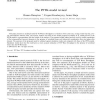Free Online Productivity Tools
i2Speak
i2Symbol
i2OCR
iTex2Img
iWeb2Print
iWeb2Shot
i2Type
iPdf2Split
iPdf2Merge
i2Bopomofo
i2Arabic
i2Style
i2Image
i2PDF
iLatex2Rtf
Sci2ools
108
Voted
COMCOM
2006
2006
The PFTK-model revised
This paper presents an analytical model of TCP Reno throughput as a function of loss event rate, average round trip time, average retransmission timeout value, and receiver window size based on the model proposed by Padhye et al. (widely known as the PFTK-model in correspondence with the initials of the authors). The presented model refines previous work by careful examination of fast retransmit/fast recovery dynamics in the presence of correlated losses and taking into consideration slow start phase after timeout. The accuracy of the proposed model is validated against simulation results and compared with those of the PFTK-model. Simulation results show that the model gives a more accurate estimation of TCP Reno throughput in the presence of correlated losses than the PFTK-model.
COMCOM 2006 | Correlated Losses | Model | TCP Reno |
| Added | 11 Dec 2010 |
| Updated | 11 Dec 2010 |
| Type | Journal |
| Year | 2006 |
| Where | COMCOM |
| Authors | Roman Dunaytsev, Yevgeni Koucheryavy, Jarmo Harju |
Comments (0)

